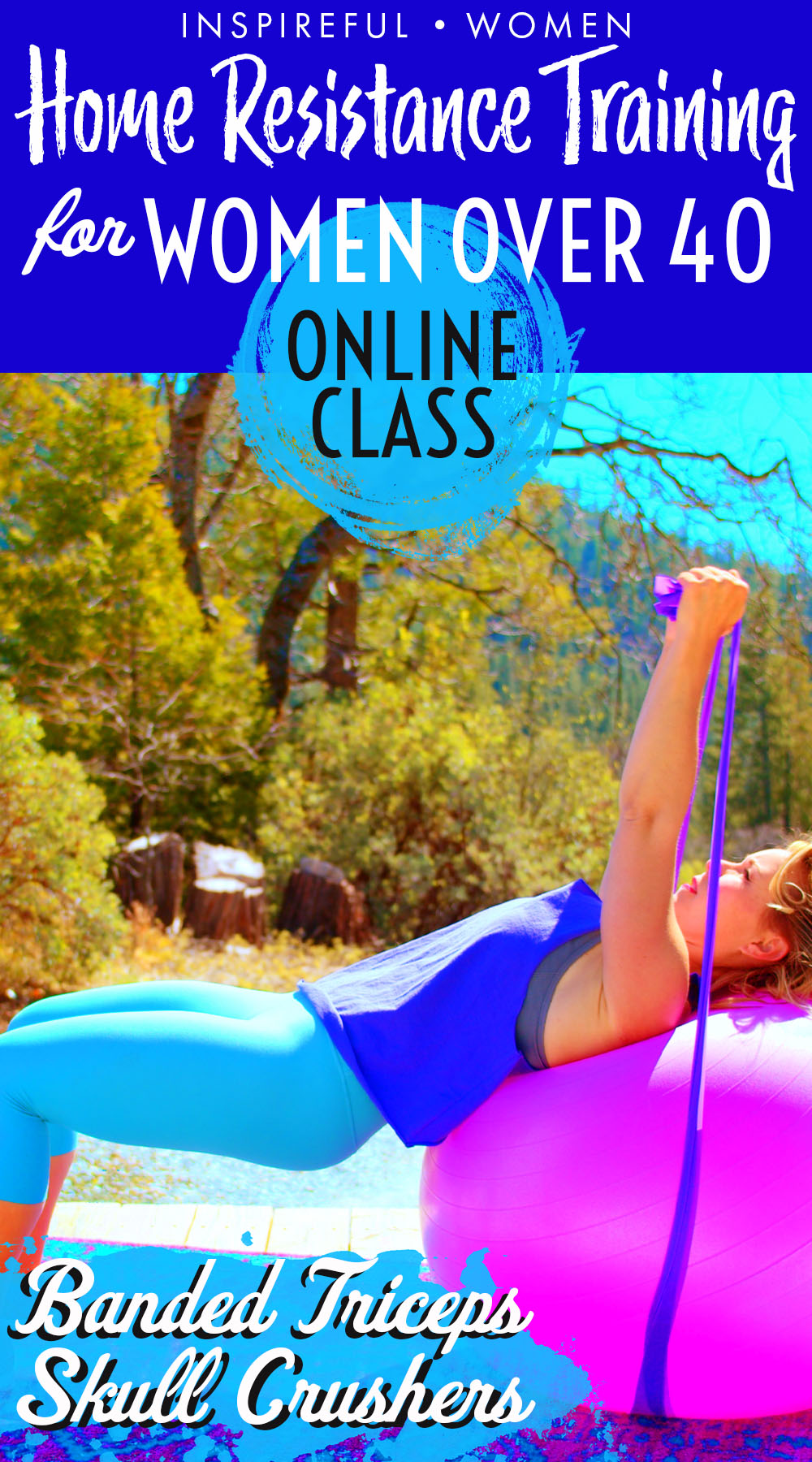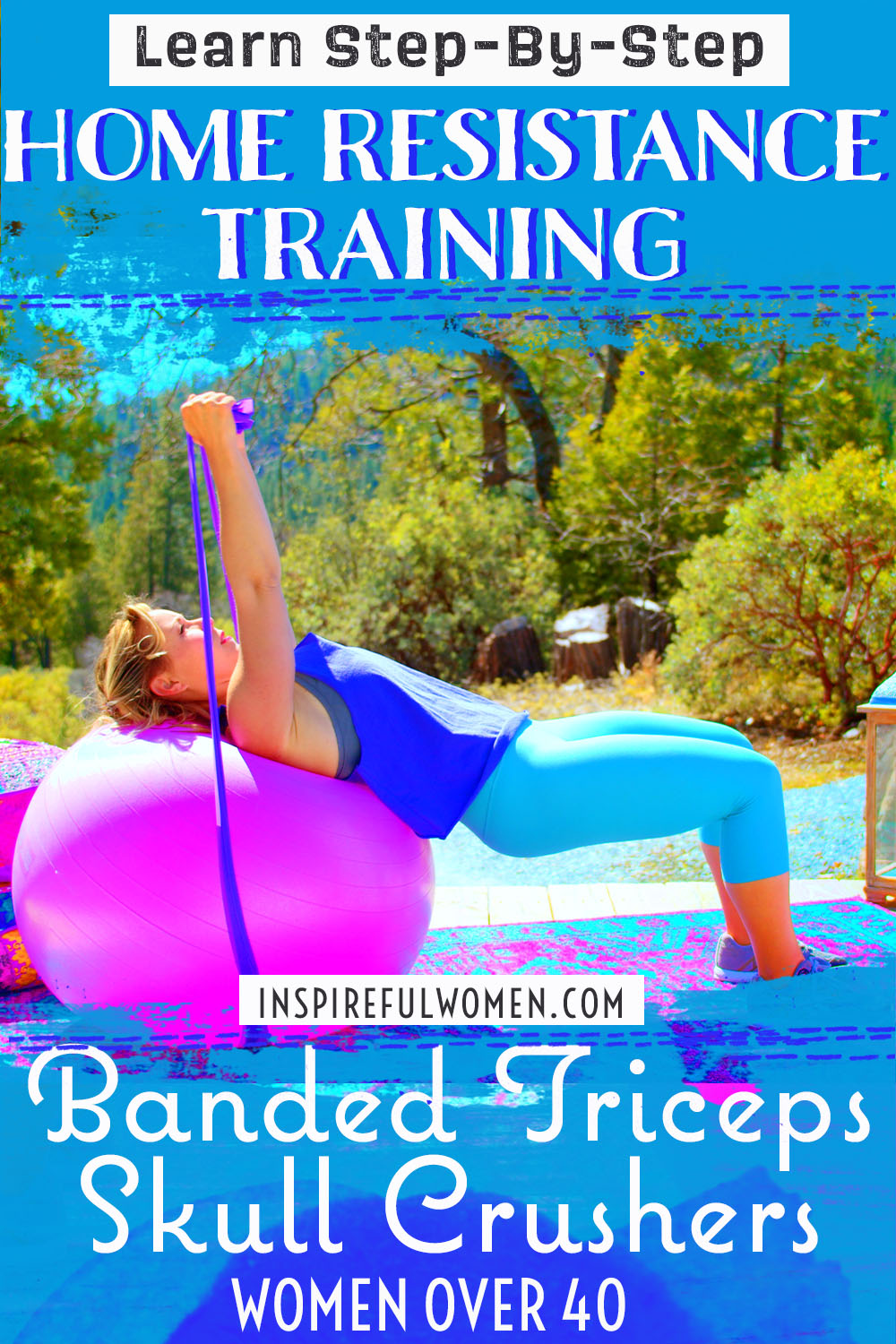Band Tricep Skull Crusher
How to Do the Lying Overhead Triceps Extension Skull Crusher - Band + Ball | In-Depth Guide [VISUAL LEARNERS] Beginner
Proper Form, Common Mistakes, & Variations | Home Resistance Training
WHAT DO YOU WANT TO SEE?
QUICK DEMO
QUICK DEMO
MUSCLES THIS WORKS
MUSCLES
MAIN MUSCLES WORKED IN Band Tricep Skull Crusher
TRICEPS
STARTING POINTERS
Starting Pointers
WHAT WE'RE DOING TODAY
Other names for this exercise: Overhead Triceps Extension - Band, Lying Banded Triceps Extensions Stability Ball, & Lying French Press
ALL WE'RE DOING:
With your torso laying on a ball that has a resistance band under it & hips held in the air, bend your elbows. Straighten them. You're done! :)-
This variation of the floor triceps extension is a little more challenging than the standard version. This skull crusher exercise is done with the body supported on a stability ball and uses a band instead of dumbbells for resistance. The muscles on the back of the upper arm (the triceps) will need to work harder to straighten (extend) the elbow when a band is used. By targeting the triceps, this exercise can help to create defined and toned arms.
When dumbbells are used, as the elbow straightens the weights will get easier to lift. When using a band, as the elbow straightens, the resistance from the band increases - so the triceps will have to work harder. Using a stability ball makes the muscles of the core and legs work harder to hold your body on the ball.
HOW TO DO THE EXERCISE
LOOKS
HOW Band Triceps Skull Crushers SHAPE OUR BODY
Balances out biceps in the upper arm, gives our upper arm that horseshoe definition which is caused by workings all three heads of the triceps. All three heads together when trained make up the "horseshoe" appearance.
PROPER FORM
PROPER FORM: Band Tricep Skull Crushers
EQUIPMENT, SETS & REPS
EQUIPMENT
Main set (3: Light/Med/Heavy)
X-Heavy Band (I recommend getting this too if you plan to use resistance bands frequently).
SUGGESTED STARTING WEIGHT FOR WOMEN:
Light to moderate resistance bands
SETS & REPS:
2 sets of 8-10, must fatigue the muscles.
PACE:
Moderate up - with control and back stability, and lower down for the eccentric component.
BODY POSITION
BODY POSITION FOR THE Band Tricep Skull Crusher
It is helpful to have your feet touching a wall to help get into the proper start position. Take a long elastic band in one hand. Run it under you, so that it ends up on the floor, and one end in each hand. The band should be on the floor right in front of the ball. Put your upper back on the ball, legs straight - like a reverse plank. Bend your knees, feet flat on the floor, and roll the ball forward so that your head ends up supported on the ball and the ball is on the band to secure it.
BODY POSITION: Lying on the ball face up. Knees bent. Shoulder blades together and down your back, abdominals engaged - neutral spine, sternum lifted, throughout the exercise. Make sure your shoulders are pushed back to the ball so the chest is open.
FEET: Feet hip-width apart, toes forward, feet flat on the floor.
HAND/GRIP: Palms facing each other (Neutral grip). The position of your forearm will not affect the triceps muscle activity - your grip should be comfortable.
ARM: Arms by your side, grip weight, and lift up to the chest. Bring your upper arms perpendicular to the floor (shoulders at 90 degrees of flexion and elbows bent to 90 degrees to begin the exercise. The elbows should be close to your head.
HOW TO DO
HOW TO DO Band Tricep Skull Crushers
CUE: Isolate the movement to your elbows. Keep your upper arms and shoulders still.
Keeping your upper arm still (perpendicular to the floor), straighten your elbow.
Make sure that your elbows are fully straight (extended) but not hyperextended (so elbow bends backwards) or locked.
Slowly bend your elbow and lower back down to each side of the head (keep your upper arm still).
Repeat until fatigue or the desired # of reps are completed.
HOW TO SAFELY GET OUT OF THE EXERCISE
Release the band. Walk your feet in and roll up to sitting on the ball.
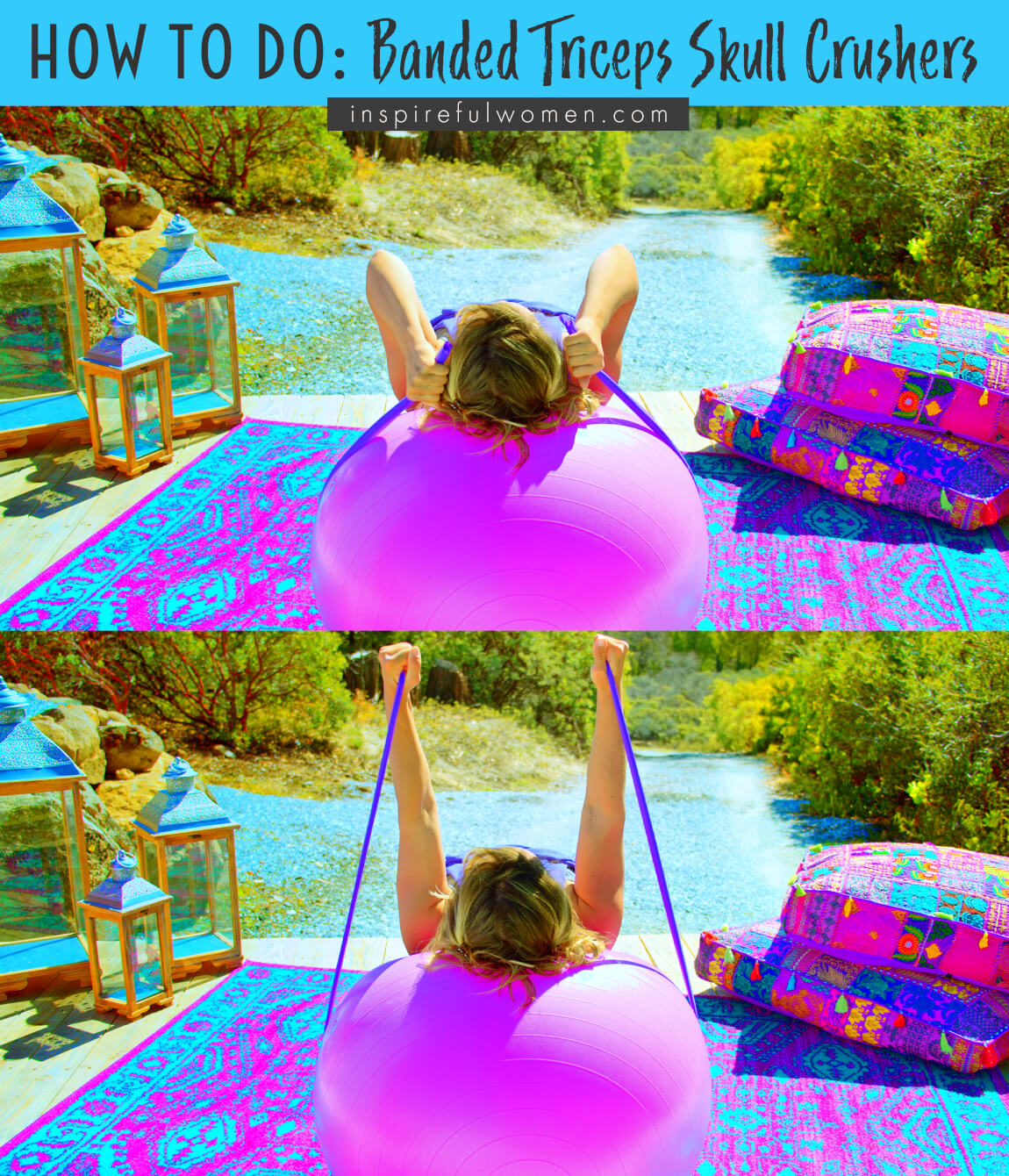
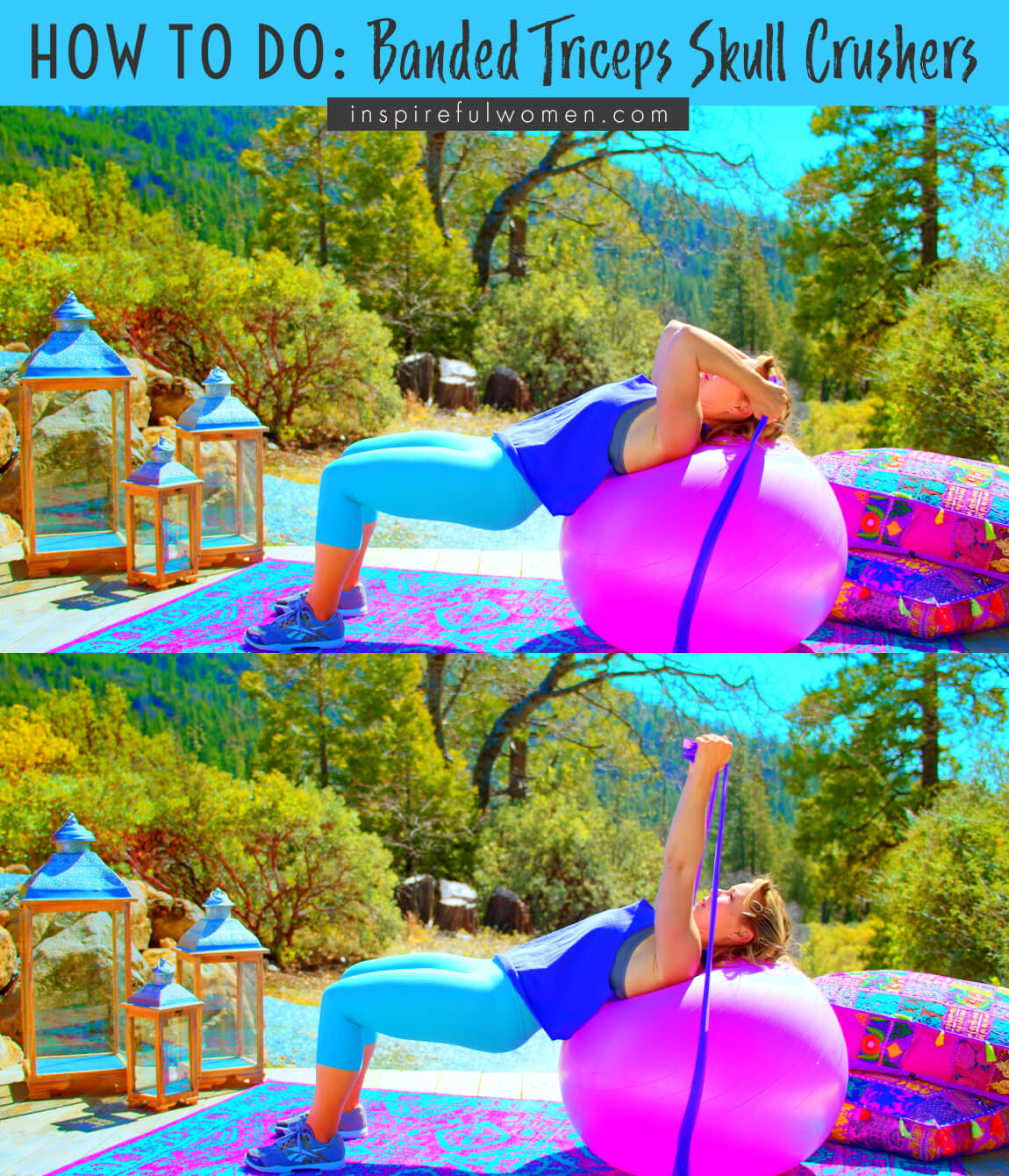
COMMON MISTAKES
COMMON MISTAKES
WHAT TO AVOID WITH THE Band Tricep Skull Crusher
KEY TIP:
Guess what? Good news! Many avoids are the same for most movements. Once you learn the basics, there's really only a few extra avoids for each individual movement.
1. Avoid Letting Your Upper Arm Drift Down
AVOID: Avoid letting the portion of your arm from your shoulder to the elbow (the upper arm) move downward.
WHY NOT?
- The upper arm is no longer perpendicular to the floor
- This will decrease the proper activation of the tricep
WHAT TO DO:
-
Point the elbows straight up to the ceiling, so that your upper arm is perpendicular to the floor.
2. Avoid shoulders hunching up
AVOID: Avoid hunching the shoulders up towards the ears.
WHY NOT?
- This can close down the space between the arm bone (humerus) and the top of the shoulder blade
- Can irritate the soft tissues
- Increases activity of the upper trapezius
WHAT TO DO:
- Keep the space between the ear and the shoulder
- Pull the shoulder blades down your back
- Lengthen the neck
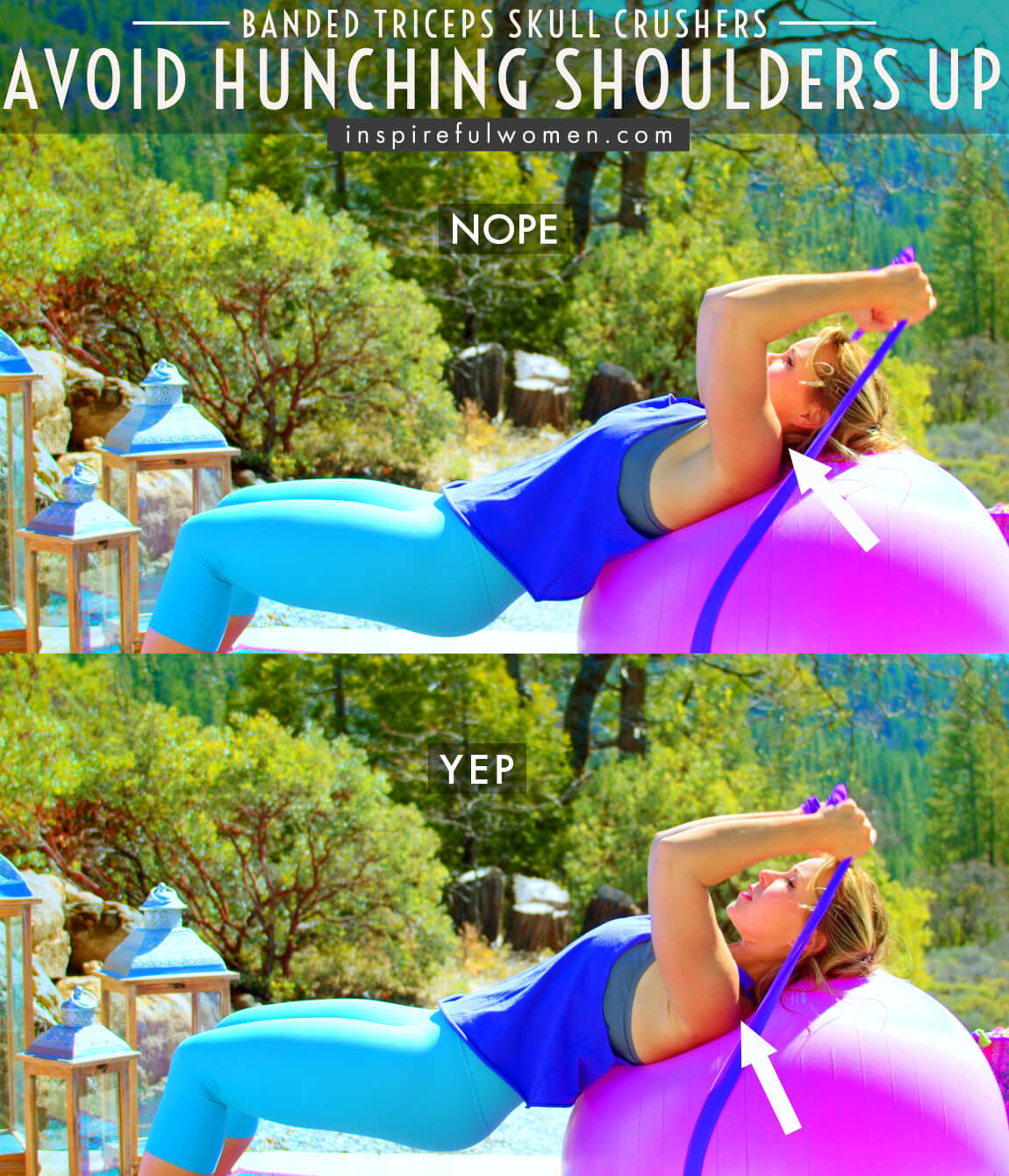
3. Avoid locking elbows
AVOID: Avoid hyperextending or locking the elbows when the arms are out straight - at the end of the movement.
WHY NOT?
- This puts too much force through the joint and may result in long-term damage over time.
- Can stretch the ligaments and tendons that support the joint.
WHAT TO DO:
- Keep the elbows slightly bent, even at the end of the movement.
4. Avoid arching your low back
AVOID: Avoid arching your low back.
WHY NOT:
- Maintain a neutral spine position to prevent low back joint injury, muscle strain or damage over time.
- Promotes poor posture
WHAT TO DO:
- If your ribs lower ribs flare upwards or your belly is lifted up - this indicates you are arching your low back. Your pubic bone and front hip bones should be in one plane - can check by placing fingertips on the pubic bone and set base of palm on hip bones - your hand should be flat.
- Arms may be too far overhead
- The upper arm should be perpendicular to the floor.
- Core muscles are not engaged
- Make sure your feet are on the floor.
- Activate your lower abdominals to hold your low back in a neutral spine position.

5. Avoid flattening your low back
AVOID: Avoid flattening your low back.
WHY NOT:
- Maintain a neutral spine position to prevent injury or muscle strain.
- Promotes poor posture.
WHAT TO DO:
- You should not be able to feel your low back pressed on to the floor, you should be able to slip your hand between the floor and your low back.
- Low back is trying to stabilize the torso.
- Make sure your feet are flat on the floor to help stabilize the torso.
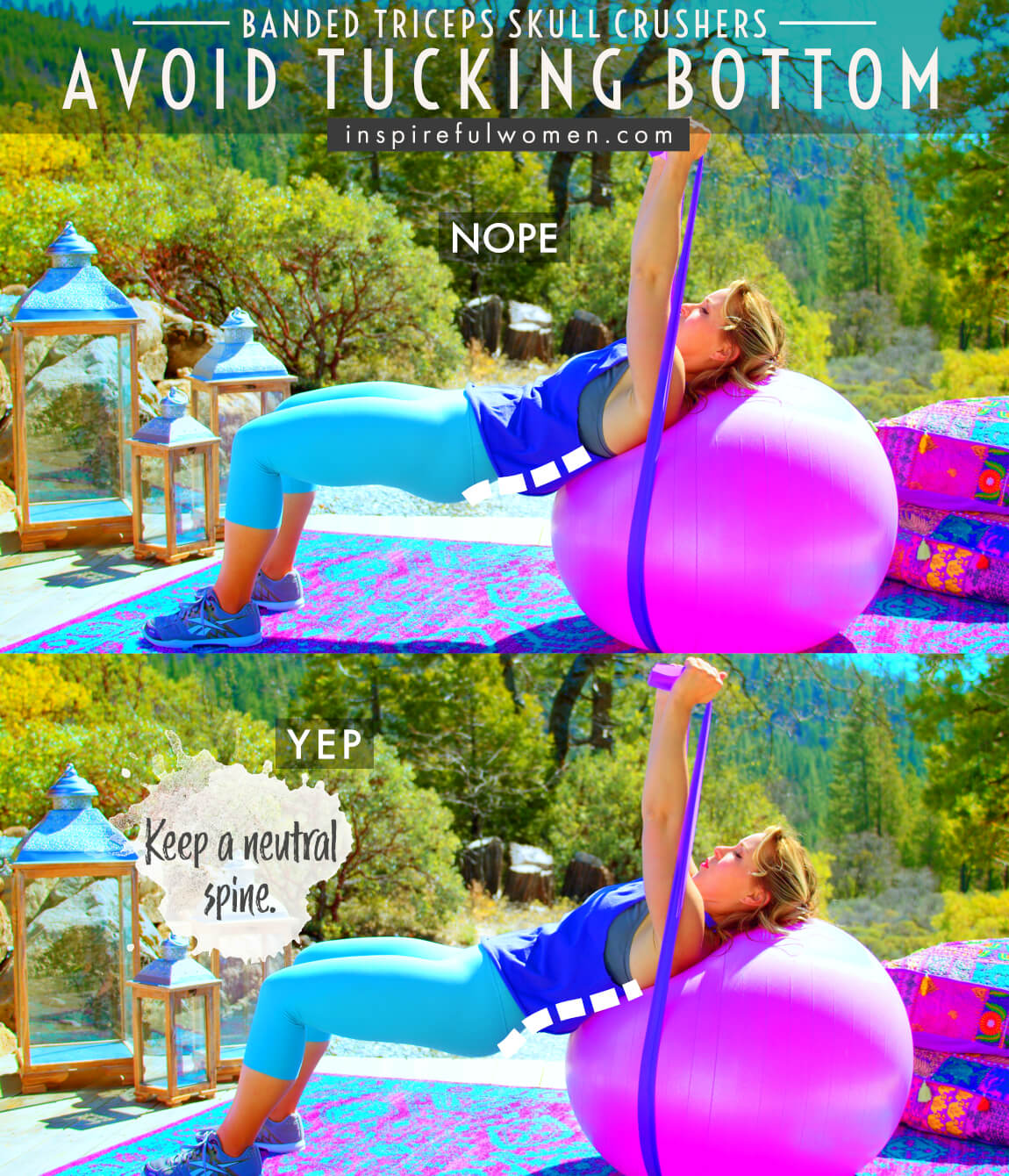
6. Avoid bending your wrist
AVOID: Avoid bending at your wrists.
WHY NOT?
- Poor alignment (bent forward or backward) or repetitive movement through the wrist can lead to joint and/or soft tissue irritation or injury over time.
- You may be substituting wrist movement for arm movement.
WHAT TO DO:
- Keep wrists in line with the forearm and still throughout the exercise.
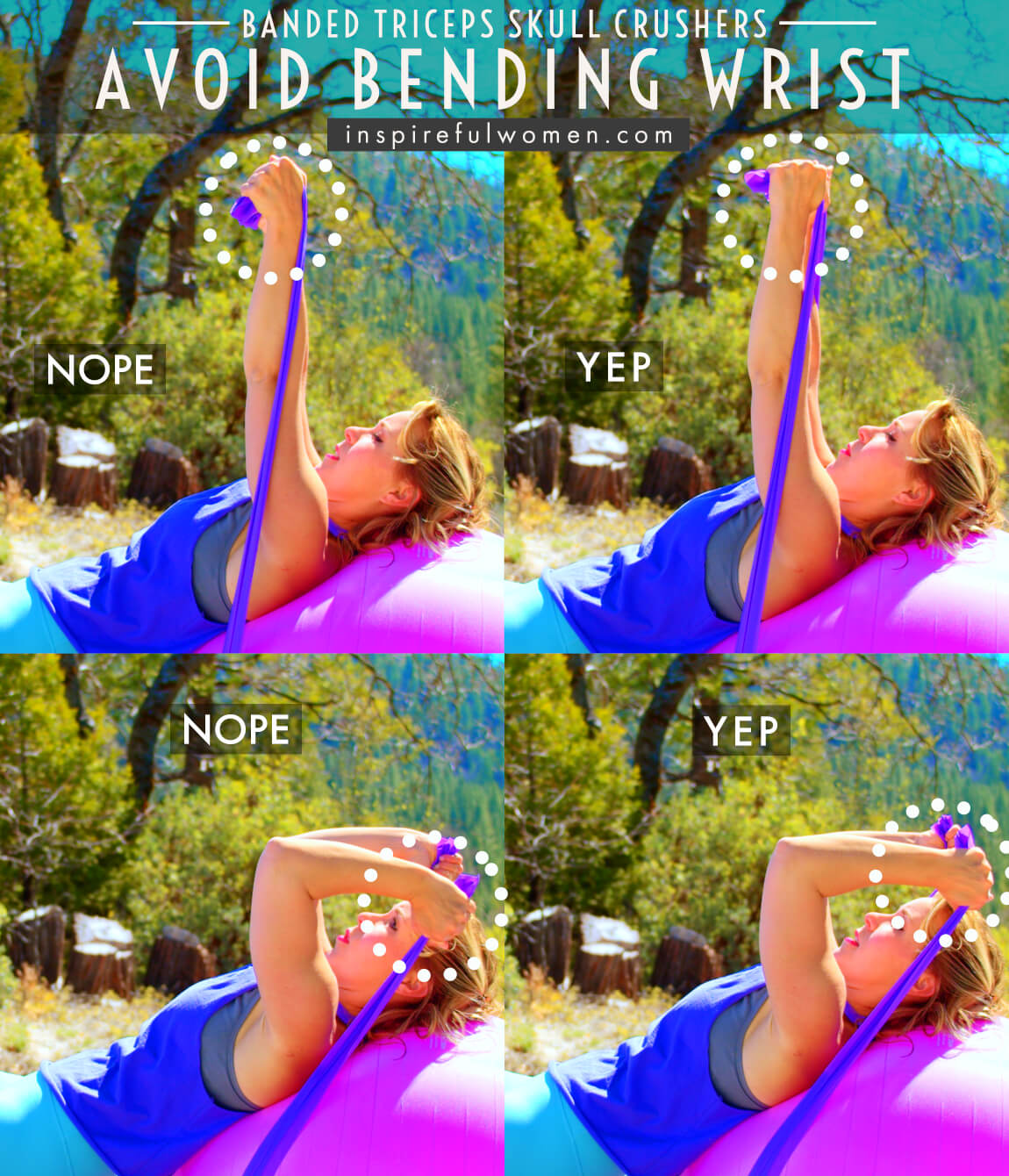
7. Avoid elbows flaring
AVOID: Avoid letting the elbows flare out.
WHY NOT?
- This moves the shoulder joint into internal rotation and decreasing the space between the top of the shoulder blade (the acromion process of the scapula) and the upper arm bone (humerus).
- This can irritate the tissues.
- Reduces the effectiveness of the exercise.
- Makes it more difficult to get full elbow extension at the top of the movement.
WHAT TO DO:
- Keep the elbows in and pointing up to the ceiling
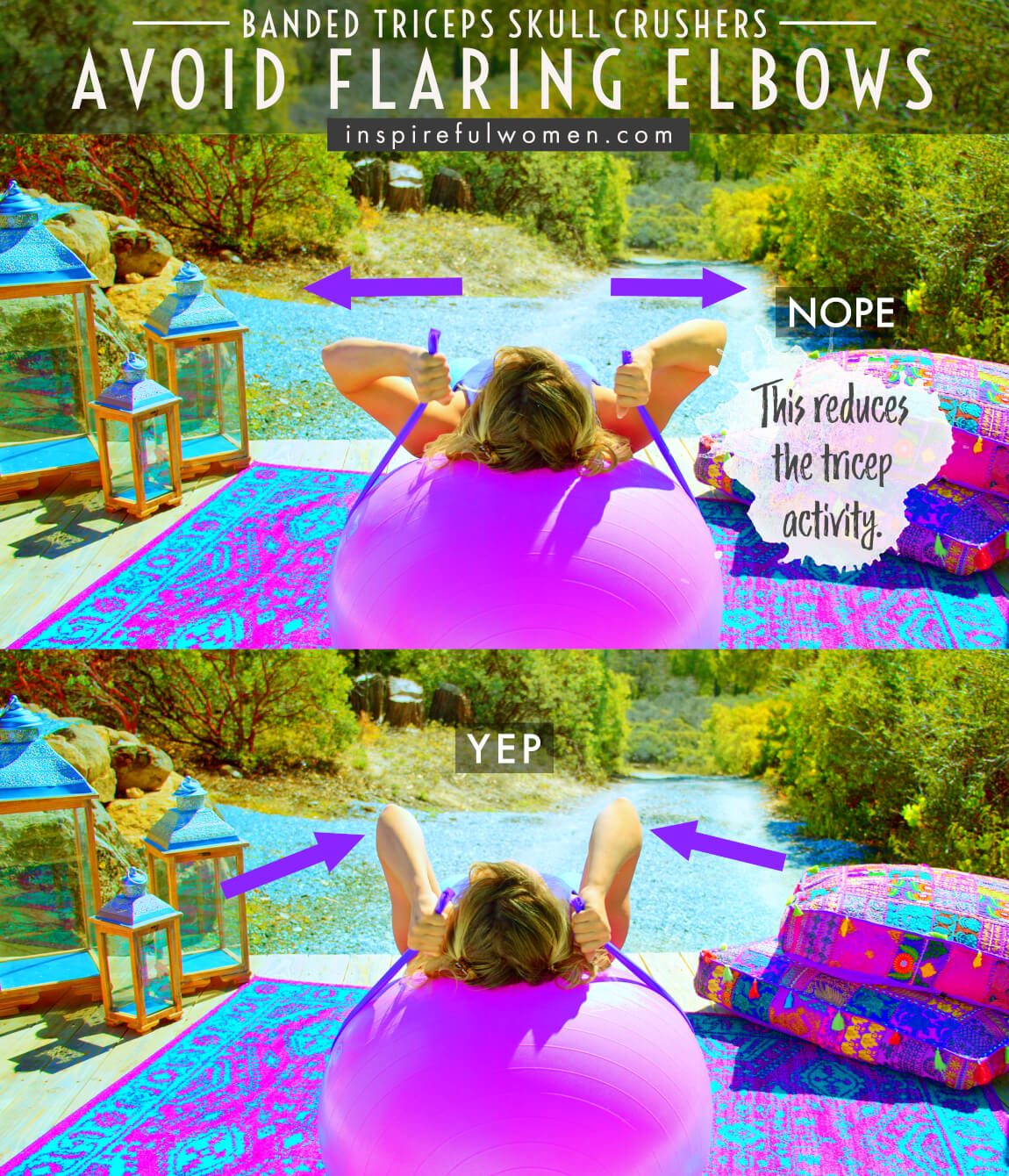
8. Avoid shoulders lifting off ball
AVOID: Avoid letting the backs of the shoulders lift off.
WHY NOT?
- This will promote poor posture
- Tight chest muscles
- Will not work the scapular retractors (muscles that pull the shoulder blades back)
WHAT TO DO:
- Press the backs of the shoulders to the floor.
- Pull the shoulder blades back.
- Lift the sternum.
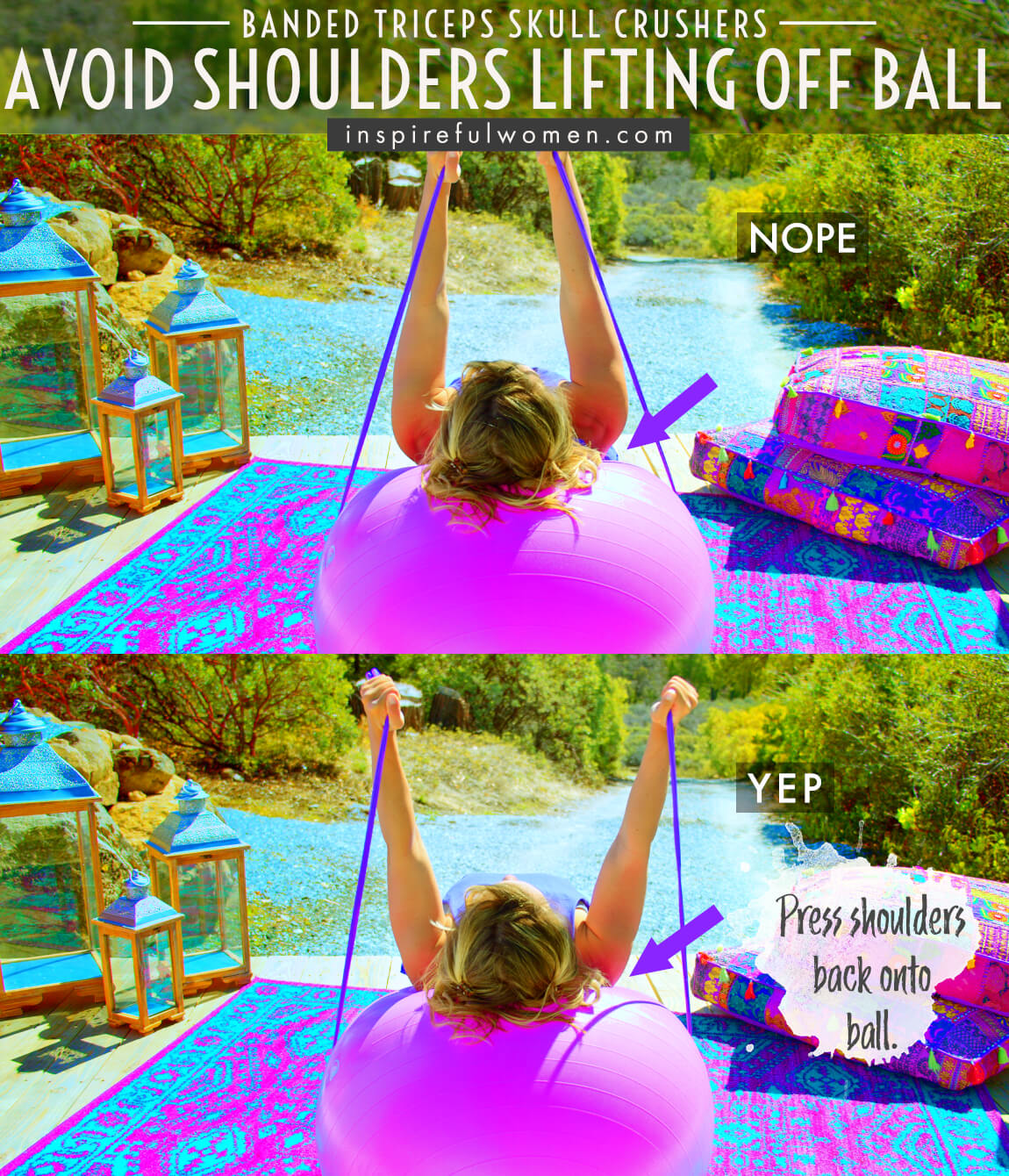
VARIATIONS
VARIATIONS
VARIATIONS OF Band Tricep Skull Crushers
upper arm higher overhead
upper arm higher overhead Skull Crusher
This variation will work the triceps muscle in a position where it is naturally weaker. Move the upper arms so that they are angled back instead of perpendicular to the floor.
This will increase the activity of the lateral and medial heads of the triceps and decrease the activity of the long head. This also changes the position of maximum torque on the elbow joint to a position where the triceps is weaker. The maximum pull of gravity on the weight is when it is held parallel to the floor. When the upper arm is angled back (more flexion), the elbow will be closer to the extension when the weight is parallel to the floor.
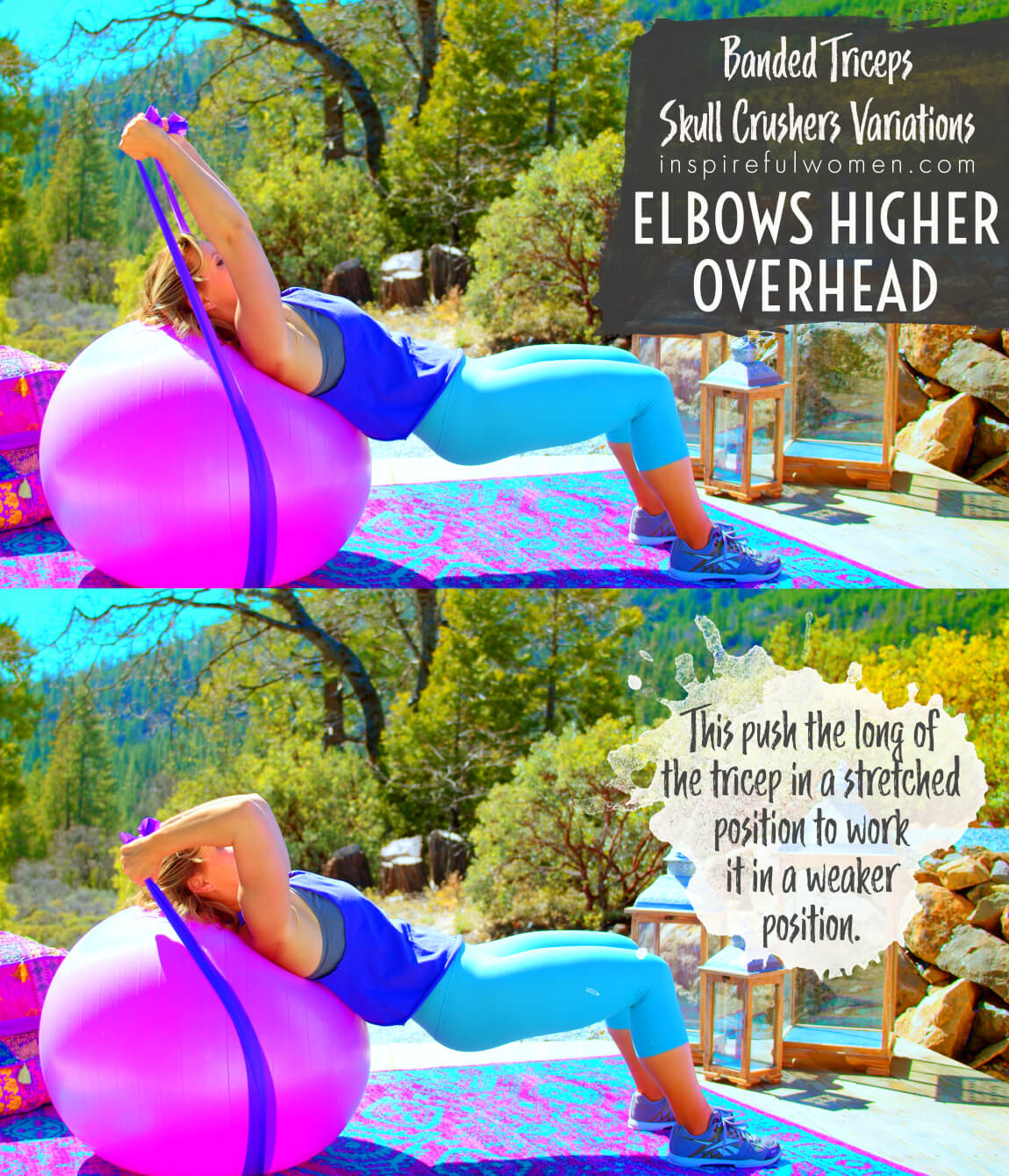
WHAT WE'RE DOING TODAY
WHAT & WHY
BENEFITS OF TRAINING THE Triceps
WHAT
Resistance Band Triceps Skull Crushers work the muscles on the back of the arm, called the triceps. The triceps cross the elbow joint and their job is to straighten the elbow.
They are called triceps because this muscle is made up of three different parts - the long head, the medial head, and the lateral (side) head. The position of the arms and the movement of skull crushers will work all three parts of the triceps.
This exercise is done lying down, face up, so it is good for focusing on the triceps muscle without having to work to hold the rest of your body still. The position also works the muscles of the shoulder and chest and back to hold the arm and weights close to the body. The movement of the exercise is simply bending and straightening your elbows.
WHY BOTHER DOING IT?
WHY
WHY DO WE EVEN CARE?
IMPORTANT MUSCLE OF OUR ARMS
The triceps muscle is the largest arm muscle and it makes up most of the bulk of the upper arm. When a muscle is a large portion of one of our limbs, that gives us the idea that it's important to a lot of what we do in life.
BALANCE OUT THE BICEPS MUSCLE
The triceps lies along the backside of the upper arm and balance out the biceps brachii muscle which lies along the front of the arm.
The triceps work with the biceps to control the movements of your arms. It is important to include exercises that work the triceps to balance out the strength of the biceps.
WE STRAIGHTEN OUR ARMS A LOT IN DAILY LIFE
We use our triceps in most daily activities, not only to straighten our elbows but to hold the elbow still when we use our hands. Since we do this so much everyday, it makes sense to strengthen the muscles that achieve this!
EVERYDAY LIFE
EVERYDAY LIFE &
MUSCLE FUNCTION
HOW WE USE OUR Triceps IN EVERYDAY LIFE
1. STRAIGHTEN THE ELBOW
This is the triceps primary function - all 3 heads do this.
- Pushing an object overhead
- Pushing a door open or shut
- Chopping - swinging down
- Hammering - swinging down
- Sawing - pushing out
- Pushing up from the floor
You can see in all these cases, your arm is going from being bent, to straightening - the triceps make this happen.
2. PULLS THE ARM DOWN WHEN IT IS OVERHEAD (1 TRICEPS MUSCLE)
The long head of the triceps muscle, the one that also crosses our shoulder joint, helps us pull our arm down fro overhead - this is calle shoulder extension.
- Pulling a cord to open a curtain
- Pulling a window down to shut it
3. HOLDS THE ELBOW JOINT STILL
All 3 heads stabilize the elbow joint while we are holding our arms/elbows in a certain position to do an activity for a length of time, and the long head also stabilizes the shoulder joint in the same manner. Examples - during:
- Writing
- Pushing a stroller or grocery cart
- Using a screwdriver or knife
- Knitting
- Replacing a ceiling lightbulb
You can see in all these cases, the arm being held somewhere in space for a length of time- the triceps muscle is helping to keep the elbow joint stable while you do that.
HOW TO FEEL WHAT MUSCLE IS WORKING
How to Feel What Muscle is Working
I think it's good to know where on our body should be working/burning when we do an exercise - this will make sure we are actually working that muscle, or to make adjustments if we are not feeling it there. It's very easy to do an exercise with improper form and have other muscles doing the work. Once we have that mind-muscle connection, we can get better results with less reps and sets.
To feel your triceps muscle activated: Lift your arm in front of you and set the hand and forearm on a table or counter. Put your other hand on the back of your upper arm. Press down with the hand resting on the surface.
1) press down as if you were trying to straighten just your elbow;
2) press down as if you were trying to pull your upper arm down to your side.
In both cases, you should feel your triceps working.
SCIENCY STUFF
ALLLL MUSCLES & WHEN
ALL MUSCLES WORKING & WHEN DURING THE Band Tricep Skull Crushers
The core muscles are active to hold the spine stable and in a neutral position throughout the exercise. The hip and leg muscles (gluteus maximus, hamstrings, gastroc/soleus) are working to stabilize the body on the ball.
The scapular stabilizers (mostly rhomboids, mid and lower trapezius, lats, pectoralis) are working isometrically to hold the shoulder blades in place to stabilize the upper arm.
The upper arm is positioned at 90 degrees of flexion in front of the body - the biceps, coracobrachialis and front (anterior) deltoid hold the weighted arm in the flexed position and stabilize the shoulder joint.
The pectoralis and coracobrachialis muscles work to hold the upper arm close to the body (adduction), so the weight does not pull the arm out to the side.
All three heads of the triceps and the anconeus (relatively small contribution) muscle contract concentrically to lift the hands and straighten the elbow.
The forearm and the upper arm muscles will work together to help stabilize the elbow joint as it extends.
As the elbow bends to return to the starting position the triceps and anconeus work eccentrically to control the load.
PIN IT FOR LATER!
